Russian Art Festival 2011
Cannes in the Russian culture age
The Russian Art Festival held from August 23 to 27, was an opportunity this year again to discover the riches of the Russian nation with its culture rich in history and traditions. It helps to maintain links of friendship between Cannes and Russia for over a century. This major event of the Cannes summer season 2011 is jointly organized by the Foundation for Russian Culture, the city of Cannes and the Palais des Festivals et des Congrès with support from the Russian Ministry of Culture. The greatest artists in painting, music, visual art, puppetry, dance, film, or Russian folk tradition, performed at the Festival, to the delight of an enthusiastic audience. Like every year, one of the days of the Festival was devoted to the cinema and were proposed not only movies by great Russian directors but also works of young talents. A selection of films to which film director and President of the Foundation of Russian Culture, Nikita Mikhalkov, is actively involved. There were the films "The Admiral", Andrei Kravchuk's historical drama, "What men talk," a comedy by Dmitri Diachenko, "The Edge", drama by Alexi Outchitel, "Spring is coming soon," melodrama by Vera Storozheva, who were offered to a cinephile audience delighted with this rich and varied production. A tribute was paid to Sergei Gerasimov with the presentation of the film "The Quiet Don". All films were in subtitled VO. From August 19 to 23, the young Russian Art met young Cannes talents, combining traditional and classical music and painting, under the patronage of Ms. Medvedeva, First Lady of Russia, like folk dances group from the Republic of Dagestan in the Palais des Festivals, concerts of classical music of the young winners of the Cannes academy at St. George and St. Margaret in Cannes la Bocca, the classical music concert of the quartet of the Gnessin Music Academy in Moscow, the military parade and concert by the Kronstadt Naval Academy cadets, or the exhibition of painting through the city of Cannes and at the Palais des Festival in the lobby Mediterranean, with the exhibition "Arabesques of the Côte d'Azur 2011". The festival of the young Russian art has been allowing for three years friendly and stimulating cultural exchanges and concerts for young Russian and Cannes talent, ahead of the great Festival of Russian Art, which deployed its splendors for the forty fifth consecutive year.

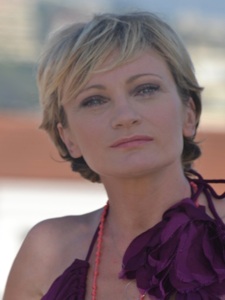
Dagestan dances : a breathtaking Caucasian enchantment
It was first in the Grand Auditorium of the Palais des Festival that was declared the official opening of the Festival by the friendly people that can be found each year, the smiling Alexander Orlov, Extraordinary Ambassador of the Russian Federation in France, Tatiana Shumova, the blonde producer of the Festival, the great Russian film director Nikita Mikhailov, Bernard Brochand, Deputy-Mayor of Cannes, and their charming translator and Executive Director. To start this high intensity and diversity program, a breathtaking Caucasian enchantment dazzled the audience with the Lezguinka folk ballet on Aug. 23.
The Dagestan Academic Ensemble was established in 1958 and composed of 45 boys and 45 girls, has performed traditional dances from Dagestan, Russia and the Caucasus. The dancers were extraordinary, both in vividness and quality of interpretation that in originality and splendor of their costumes. All was gathered to inflame the large and completely captivated audience by the exploits of proud Cossack who were rivaling in performances with an energy and an irresistible joy, warriors with fine, nervous and sharp legs, wearing daggers, dancing on tiptoes and making incredible and breathtaking leaps or whirling on their knees. Oriental-like dressed beautiful women were as gracious and charming that male dancers were energetic and both composed irresistible and romantic scenes when dancing together.
Patricia Kaass’ Russian Night
On Thursday, 25, a journey through Russia was offered with the Russian Night at the Palais des Festivals Salon des Ambassadeurs, in collaboration with Russian TV channel Red Square Studio. A dinner-show where haute cuisine, haute couture and scenic arts Russian were rivaling in virtuosity to seduce the audience senses. On the agenda: the soloists of the folkloric ballet "Lezguinka", folk songs of Khakassia with the Ulguer group, folk groups from the region of Lipetsk, a fashion show by Alexander Terekhov, and a step duet with Konstantin Nevredinov and Victoria Sichalova, the Levon Oganezov's Jazz Band, the Russian pop stars Marck Tishman, Victoria Dayneko, Alexey Chumakov, Yula and Maria Kovalchuk Vorovona with the special guest of the Russian Night, the band Dio Filmi (Ukraine). To mark this event, a trophy was awarded to Patricia Kass for her outstanding contribution to the development of cultural relations between France and Russia. Indeed, since twenty years the "little girl from Lorraine" has been living a love story with the Russian public, as far as becoming a true icon on the other side of the Balkans. She was elected French personality and cultural ambassador of the year. Moreover, during her interview in the afternoon in one of the suites of the palace Majestic Barrière, this international star with sixteen million albums sold worldwide, said she dreaded this evening and that she was very moved and happy, but she hadn't expected receiving a distinction to appreciate all what she shares with this people. "The best reward is not held in the hand," she said, but "it is rather the incredible loyalty of this so sensitive audience". At 10:00 p.m., guests were privileged to attend, from the terrace of the Salon des Ambassadeurs, to blazes of light in the bay of Cannes, thanks to the talent of the Panzera fireworks company.
Puppetry and shaman mysteries from Khakassia
Friday 25, a fascinating journey in "Amazing Country" Khakassia, invited onlookers to re-discover this young republic of the Russian Federation which is celebrating its tenth anniversary, with its famous National Puppet Theater crowned by the most prestigious awards which was presenting "The Tale", an epic poem that traces the journey of initiation of a small emblematic hero from this land of legends and spells, Keri Saryk, tempted by a serpent. He meets gods and demons, a dragon deck and becomes a man. Puppets manipulated by actors in shaman costumes, mysteries, masks, expressive figurines, adventures to the rhythm of a Khakassian drum, voiceovers in Russian and French, the spell in the magical sense of the word operates, made up tipsy by the vodka, champagne and Russians chocolates and left us both fascinated and dreamy.
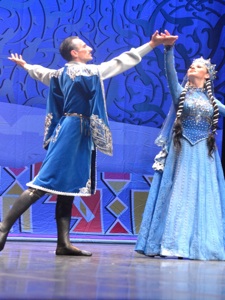
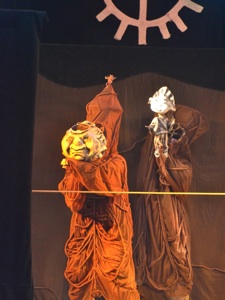
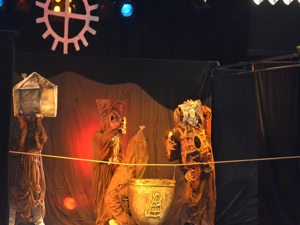
The Tsar’s bride
Saturday 27 for its closure, the Festival of Russian Art, which attracted more than six thousand spectators, found its climax with one of the most fabulous Russian opera that Diaghilev made known to the world with his ballets at the beginning the twentieth century, "The Tsar's Bride," an opera in four acts with live music from Opera-Helicon chorus and soloists. Directed by the masterful Dmitri Bertman during the reign of Tsar Ivan the Terrible, where dramas of love, revenge and power, were tied under the dark vaults of palais. Everything was gathered to please eyes and ears with Rimsky Korsakov's music, this amazing lyric storyteller. The sonorous and magnificent voices, the expressive playing of the singers, the costumes and headdresses of a sober richness in dark tones, attuned to the drama, and the perfect direction by Evgny Brazhnik, at the head of the Opera-Helicon orchestra, the National Theatre of Moscow. This sumptuous and last night put everyone, Russian and Cannes organizers and spectators, in the fever of what is being prepared for the jubilee of the Festival fifteenth anniversary. In apotheosis of this fabulous journey through Russia, and in gun salute, the victory of the Pyrotechnic Art Festival, everyone made an appointment in 2012.
Russian Art Exhibitions
In the the Palais des Festivals Espace Toscan du Plantier, two exhibitions were to discover. "The Tree of Life", from the Lipetsk region, which described the calendar four seasons: winter and its laces inspired by the drawings of frost, spring with the tree of Easter, its pearl eggs and clay toys, summer, its quilts, its colorful small multicolored rugs and paintings on wood signed by master craftsmen, and fall, the time of marriage and crops with traditional embroidery. The second one, "Eternal Kaskassia", was reflecting the charm and natural beauty of this almost unknown land situated between Mongolia and Siberia, whose traditional crafts are of great diversity and great purity with wooden sculptures, ritual crockery, decorated pipes, ceramics, embroidery with glass beads, sumptuous costumes with a strict cut.
Music and dance traditions of Khakassia put forward
On August 26, the Symphony Orchestra of the Republic of Khakassia and folk ensemble Ulger gave a rich and colorful musical and dance spectacle to have Cannes public discover cultural traditions of Khakassia. Founded in 2000, the Symphony Orchestra of the Republic of Khakassia has a rich and varied repertoire ranging from classical music to the works of contemporary Russian and foreign composers. It pays special attention to carry on traditions of ethnic Khakassian music. "Alype Khan" is the bright illustration of that. Created from a Khakassian epic poem, this work unit traditional music performed by the symphony orchestra and diftonique singing carried by E. Oulugbachev, a Master of exception, honored artist of Russia. Conducted by Viatcheslav Inkigikov, Emeritus Master of Arts of Russia, the orchestra with impassive asian musicians under their fur hats in these hot days, playing their typical instruments of sculpted wood, inlaid with silver, and the richness of their round beads, embroidered silk costumes, took us far from France and into this remote area. In the second part of the evening, the folk ensemble Ulger enchanted the public with the traditions of Khakassia culture through dances, songs and tunes of this republic from Siberia to the sound of musical instruments like the popular khobrakh, the pyrguy or khomys.

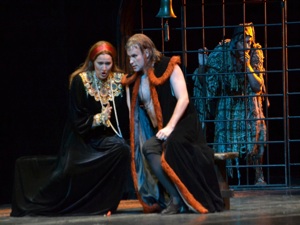



copyright 2010/11 YesICannes.com

